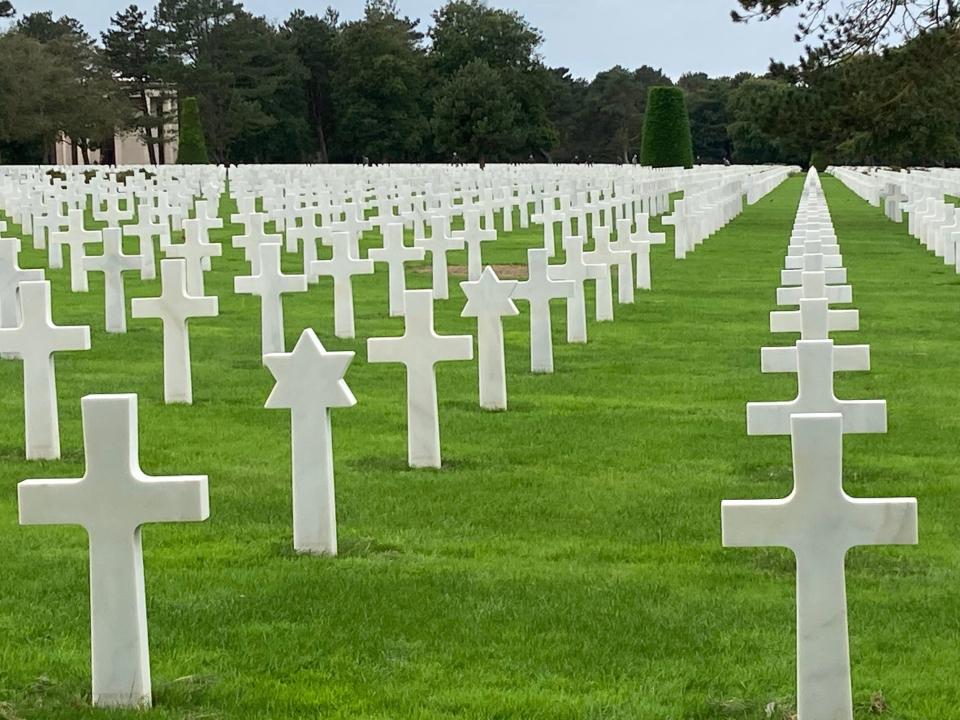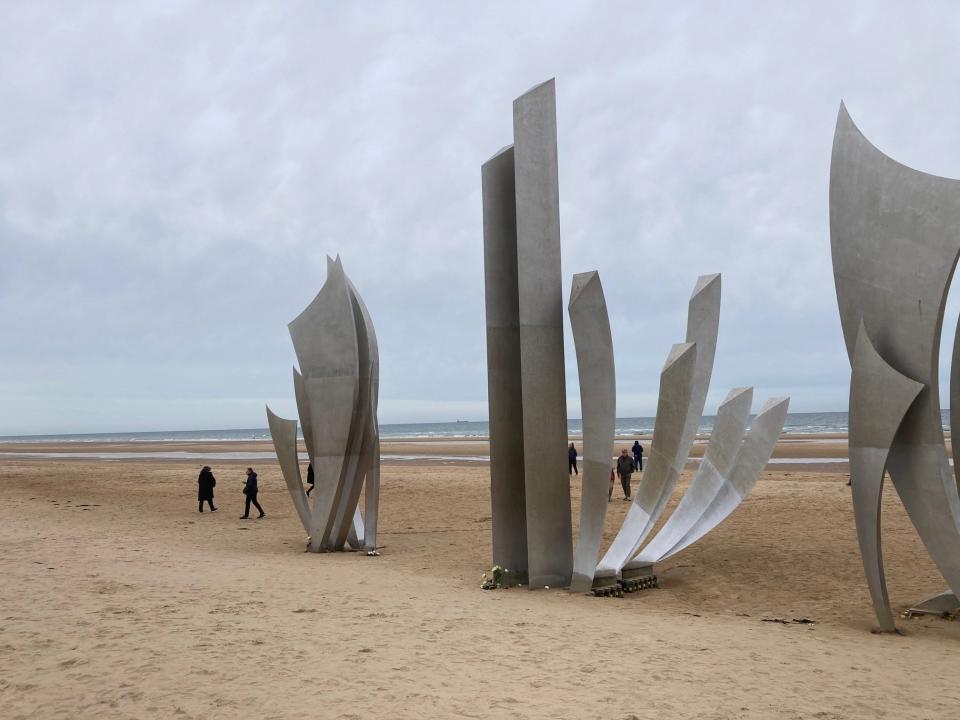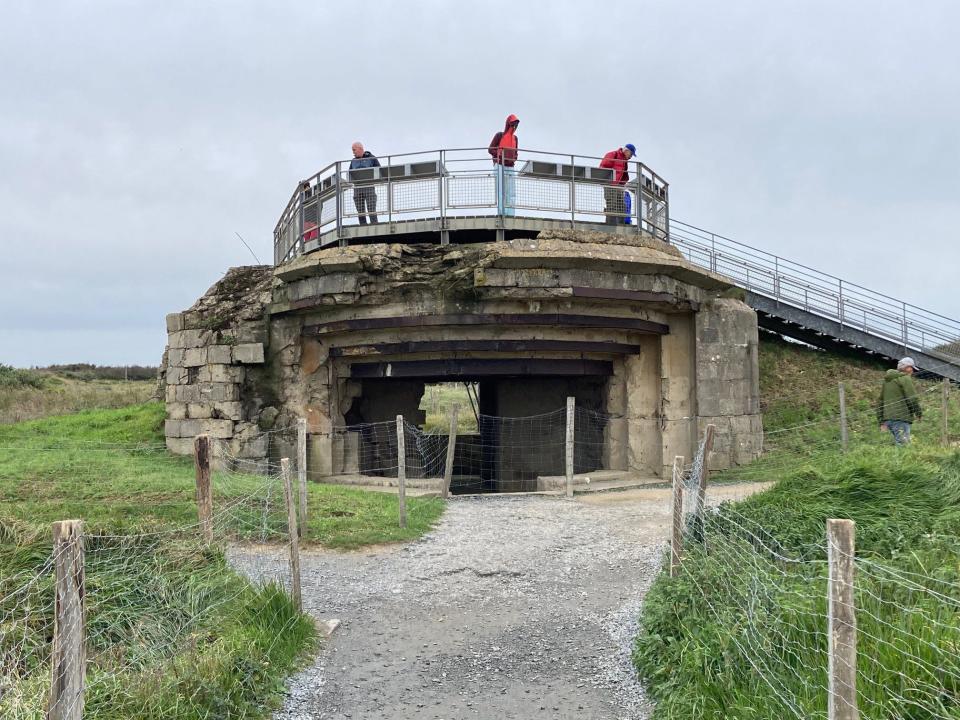The D-Day beaches in France and the Caen Peace Memorial Museum honor America’s heroes
France is a country riven by war for centuries. Invasions by Vikings, Normans, the English and others have seen battles play out for eons. Our recent Seine River cruise took us past several old fortifications signifying the country’s history of armed conflict, such as the ruins of the Chateau Gaillard, a fortress built in 1196–97 by Richard I of England (Richard, the Lionheart), to protect from attack from the army of the French king, high above the Seine River and small town of Les Andelys. France is also site of some of the most frightening battles which occurred in both World War I and World War II.
The highlight of our recent two-week trip to Paris and a cruise down the River Seine through Normandy was our D-Day battlefields tour. Our motorcoach took us first to Pointe du Hoc and Omaha Beach, a site that Normandy veterans know well. Here the D-Day landings unfolded, code named “Operation Overlord”, the largest military campaign in recorded history. General Dwight Eisenhower exhorted his command, “Full victory – nothing else”.
Early in the morning of June 6, 1944 nearly 7,000 ships and landing craft converged on the beaches of Normandy carrying thousands of soldiers from the United States, Great Britain, Canada and other Allied nations as well as tanks, trucks, big guns, jeeps, and other war material. My own 101st Airborne Division (I was a 101st Airborne platoon leader, Vietnam, 1971–72) and US 82nd Airborne Division parachuted in above Utah beach to get behind the German fortifications, losing many of their paratroopers even before they hit the ground.

The French beaches, running south to north, were named Utah, Omaha, Gold, Juno and Sword. The hills and ridges above the beaches were guarded by a long dug-in, heavily-fortified German force, equipped with machine guns, 155 mm big guns, antiaircraft guns, and thousands of Nazi troops, all protected by heavy fortifications constructed since Germany’s occupation of France years earlier.When the Allies landed on the sandy beaches, the Nazis unleashed a ferocious barrage of German gunfire from their secure fortifications. Scores of Allied fighters were mowed down while exiting the Higgins landing craft and wading to shore. In time, the battered brigades managed to cross the open sand, climb the ridges and battle the Germans, hand to hand. More than 1,000 allied troops died just on Omaha beach that day alone.

Our tour took us through the Pointe du Hoc area, wandering through the area’s Nazi fortifications, built of 6-foot-thick concrete walls and ceilings with gun ports looking down at Omaha beach below. Army rangers scaled the cliffs below Pointe du Hoc to silence the German artillery and machine guns, suffering casualties (killed or wounded) to over two-thirds of their troops. To stand in several Nazi pill boxes and look through the gun slits at the beach just below was an unsettling experience to me, my wife and 22 other veterans, part of our tour group.
After a stop at a local restaurant for lunch we continued on to the American Military Cemetery, high above Omaha Beach. Here over 110 acres are dedicated to honor the 9,386 American soldiers who were killed that day and the days following. My fellow veterans and I took part in a moving memorial service, honoring the American heroes. To then walk the perimeter of the cemetery, past row upon row of marble white crosses and Stars of David made for a day I will never forget.

On the next day, our tour stopped for a three hour visit at the Peace Memorial Museum in Caen. This state-of-the-art museum offers unique insight into the D-Day invasion, the Battle of Normandy and its place in the liberation of both France and Europe. Extensive photos, panoramas, audio recordings, movies, Allied and Nazi equipment displays make for a moving visit.
Earlier in our tour of France, our group visited the area of Belleau Wood and the Aisne-Marne American Cemetery. Here the battle of Belleau Wood was fought in June, 1918, between the 2nd and 3rd Divisions of US Army Marines along with French and British troops against a large assortment of German combatants. Over 1,800 Americans are buried here; once again, the rows of white crosses in the French countryside honoring our GIs offer further evidence of why most of the French have such gratitude that for the support of the USA and its troops in both World War I and World War II. The battle has been enshrined in US Marine lore due to the bravery exhibited there.
As we approach our nation’s Veterans Day memorial services coming up Nov. 11, please reflect upon and honor our armed service veterans who have served the country with dedication and gallantry.
For more info: D-Day invasion, army.mil/d-day/history.html; and, eisenhowerlibrary.gov; Grand Circle Cruises, gct.com; Peace Memorial Museum, Caen, Normandy.memorial-caen.com; Seine River Valley, france.fr/en/normandy/article/seine-valley-normandy/amp.
Where are you traveling? Contact Tim, tviall@msn.com; explore your world.
This article originally appeared on Visalia Times-Delta: The D-Day beaches honor America’s heroes

